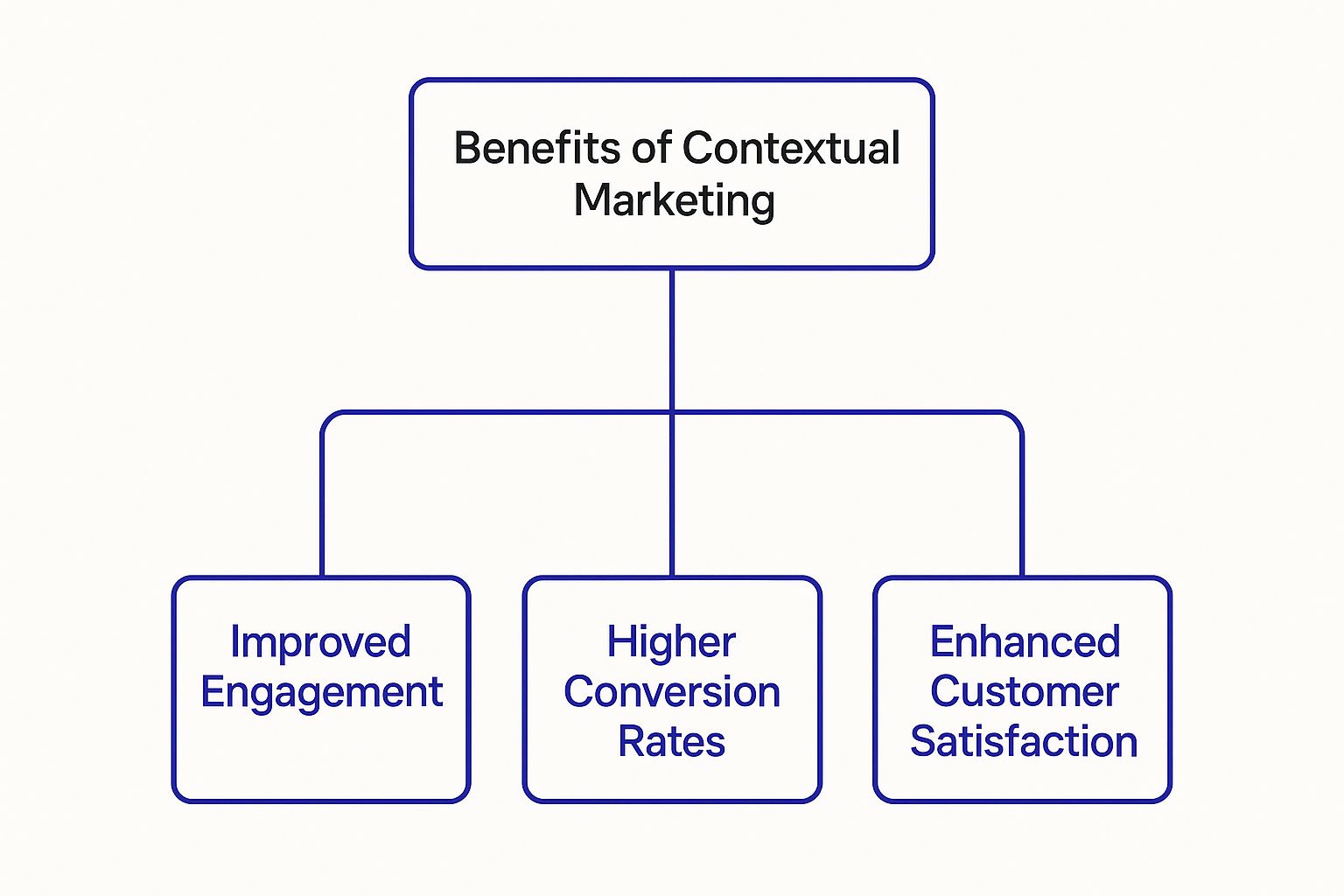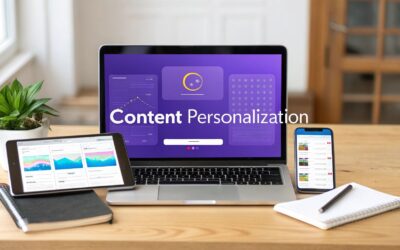Contextual marketing is all about showing the right message at the right moment. Instead of digging into a user's past browsing history, this strategy delivers content or ads based on their current environment and what they’re doing right now. It’s a smarter, more intuitive way to connect.
Understanding Contextual Marketing In A Privacy-First World

Think of it like this: you're in a bookstore browsing the science fiction section, and a helpful employee points out a new release from an author you might like based on the books you're holding. That's contextual marketing. It's timely, relevant, and genuinely useful.
Now, imagine that same employee following you around for weeks, making a list of every book you've ever glanced at, and then shouting recommendations at you in the parking lot. That’s the old-school approach of behavioral marketing, which leans heavily on personal data and third-party cookies.
As people become more conscious of their digital footprint and privacy laws get stricter, the days of the third-party cookie are numbered. This is where contextual marketing truly shines. It doesn't need to know who you are, just what you're interested in at this exact moment.
The Core Idea: Context Over History
The fundamental principle is simple but powerful: relevance comes from the immediate situation, not a long-term user profile. Rather than building a complex picture of a person over weeks or months, this approach zeroes in on the here and now.
This isn’t just a passing trend; it's a massive market shift. The global contextual marketing market is exploding, projected to jump from USD 198.4 billion to nearly USD 748.5 billion by 2034. That's a compound annual growth rate of 14.2%, as detailed in a recent contextual marketing market report. This incredible growth shows a clear move toward connecting with audiences in a way that is both effective and ethical.
To really nail down the difference, it helps to see the two approaches side-by-side.
Contextual vs Behavioral Marketing at a Glance
| Aspect | Contextual Marketing | Behavioral Marketing |
|---|---|---|
| Data Source | Focuses on the content of the current page, device, location, or time. | Relies on historical user data: past searches, sites visited, and purchases. |
| Privacy | Privacy-friendly; doesn't require personal data or third-party cookies. | Depends heavily on cookies and user tracking, raising privacy concerns. |
| User Experience | Ads feel relevant and integrated, like a natural part of the content. | Ads can feel intrusive or "creepy," following users across the web. |
| Timing | Captures user intent in real-time, at the exact moment of interest. | Targets users based on past interests, which may no longer be relevant. |
Ultimately, contextual marketing offers a better, more respectful way to engage with people.
How It Delivers Real Value
By matching your message to what a user is actively thinking about, you can hit several key goals at once:
- Build Trust: You show respect for user privacy by ditching invasive tracking methods.
- Boost Engagement: A message that fits the user's immediate interest is far more likely to grab their attention and get a click.
- Improve the Experience: Your marketing stops feeling like a jarring interruption and starts feeling like a helpful suggestion.
The Pillars of a Strong Contextual Strategy
To really get what contextual marketing is all about, you have to look at its core building blocks. These pillars are what turn a generic, one-size-fits-all message into a personal, timely, and genuinely helpful interaction for your visitor. A truly effective contextual strategy goes way beyond just matching keywords; it’s about understanding what’s happening in your user’s world right now.
The first and most fundamental pillar is Content Analysis. Imagine a super-smart digital librarian that reads a webpage and instantly gets the main idea, the overall theme, and even the emotional tone. It can easily tell the difference between a blog post cheering on marathon runners and a somber news report about a marathon-related accident. This is what ensures your ad for running shoes shows up on the first page, not the second.
Understanding the User's Environment
Next up is the User's Environment. This is where things get interesting because it adds a layer of real-world details that have nothing to do with the page content itself. Instead, it looks at the practical factors shaping a person’s experience at that very moment.
Think about details like:
- Device Type: Is your visitor on a tiny phone screen or a big desktop monitor? A mobile user might get a simple "tap to call" button, while a desktop user sees a more detailed form.
- Geographic Location: Someone browsing from snowy Chicago in January should probably see your ad for winter coats, not the one for swim trunks you'd show to a visitor from Miami.
- Time of Day: A local coffee shop's website can smartly promote a breakfast combo in the morning and switch to a happy hour special in the afternoon.
This graphic breaks down how these pieces fit together to deliver the powerful benefits of contextual marketing.

When you combine these elements, your marketing messages just click. They feel more relevant, which naturally leads to better engagement and, ultimately, more conversions.
The final, most dynamic pillar involves Real-Time Triggers. These are external events that can change a user's needs in an instant. A sudden rainstorm, for example, could trigger local ads for umbrellas or food delivery. This ability to react to what's happening outside the browser makes your marketing feel perfectly in sync with the user's world.
What Are the Real Benefits of Contextual Marketing?

Shifting to a contextual strategy is about more than just playing by new privacy rules; it's about getting much better results. The biggest upside is that you’re future-proofing your marketing. As the digital world continues to prioritize user privacy, this approach keeps you ahead of the curve.
Contextual marketing naturally respects user consent and aligns with regulations like GDPR. By moving away from invasive third-party tracking, you build genuine trust. When customers feel respected, not spied on, they see your brand in a better light and are far more open to what you have to say.
Drive Deeper Engagement and Relevance
Imagine delivering a message that perfectly matches what a user is thinking about right now. That’s the power of context. Instead of showing them an ad for something they looked at last week, you're connecting with them while their curiosity is fresh and active.
This kind of immediate relevance pays off in several big ways:
- Higher Click-Through Rates (CTR): When an offer or message aligns with the content on the page, it feels like a helpful suggestion, not a random interruption.
- A Stronger Brand Image: Your brand becomes synonymous with timely, useful information that actually helps people.
- A Better User Experience: You’re adding value to their visit, which is a fundamental part of learning how to increase website engagement.
The idea is simple, really. Marketing that helps people find what they're already looking for will always beat marketing that interrupts them with something they're not. It's a win-win for everyone involved.
Get More Bang for Your Buck
Finally, contextual marketing is often much more cost-effective. You're not just throwing money at a massive, data-hungry net and hoping for the best. Instead, you're focusing your budget on placements where you know the audience is already interested.
This efficiency is why the industry is paying attention. The contextual advertising market is projected to grow at a CAGR of 16.73% through 2034, and it's no surprise. Today, around 74% of marketers are already using contextual data to target their campaigns. It just works.
The Tech That Makes Contextual Targeting Smart
Forget the old days of contextual marketing, where an ad for cameras would just show up next to the word "photography." That was the blunt-force approach. Today's technology is a whole lot smarter, capable of understanding content with a nuance that feels almost human.
The magic behind this evolution is a combination of Artificial Intelligence (AI) and Natural Language Processing (NLP). These aren't just buzzwords; they represent a fundamental shift. Instead of just spotting keywords, these systems analyze the feeling of a page, identify the core topics, and understand the complex relationships between different ideas. This is absolutely crucial for brand safety.
Think about it this way: NLP can easily tell the difference between a travel blogger's exciting story about a flight to Bali and a grim news report about a plane crash. An airline's ad belongs next to one of those, and definitely not the other. This ensures the brand’s message reaches a receptive audience and protects its reputation from disastrous associations.
It's All About Understanding the Meaning
Diving a bit deeper, the real engine here is semantic analysis. This is the process of figuring out the intended meaning behind the words, not just the words themselves. It’s about grasping the core message of an entire article or webpage.
This leap forward allows technology to understand content as a human might, paving the way for more suitable and effective messaging that aligns with a user’s immediate context rather than their historical behavior. Discover more about the future of contextual advertising.
Bringing This Power to Your Own Website
The great news is that you don't need a massive ad network to use this kind of logic. You can apply the same principles right on your own website. By using tools that control what content appears and when, you can build incredibly relevant experiences for your visitors.
Imagine showing a special message to someone based on the specific blog post they're reading, their geographic location, or even the time of day. This is how you transform a static site into a responsive, personalized journey. It’s a core concept behind working with Divi dynamic content, where you use these kinds of triggers to make every visit feel unique.
How to Put Contextual Marketing Into Practice on Your Website

Getting contextual marketing up and running on your own website is probably easier than you think. You don't need a huge ad spend to make it happen. What you really need are the right tools to control what your visitors see—and when they see it. This is where the theory hits the road.
The whole idea is to use contextual triggers to display specific content. This turns a generic, static page into a dynamic experience that feels responsive to the user. With a plugin like Divi Areas Pro, for example, you can create simple rules that show or hide different elements on your Divi site based on all sorts of conditions.
Setting Up Your Contextual Triggers
The heart of on-site contextual marketing is defining your conditions. Think of them as simple "if-then" statements that control your content. For instance, if a visitor is on a smartphone, then show them a banner to "Download Our App." It's that straightforward.
Here are a few practical examples you could set up in minutes:
- Time-Based Offers: Does your restaurant have a happy hour? Show a special banner for it, but only on weekdays between 4 PM and 6 PM.
- Location-Specific Deals: You could display a unique free shipping offer that’s exclusively visible to visitors from a certain country or state.
- Device-Centric Content: Show mobile users a simplified call-to-action button, while desktop visitors see a more detailed sign-up form.
This screenshot from Divi Areas Pro shows just how easily you can stack multiple conditions to create a really specific rule for who sees your content.

By layering rules like the user's role, the current date, and the page they're on, you can make sure your message hits the right person at the perfect moment.
A Real-World Scenario
Let's walk through a common example. Imagine you run an e-commerce store and want to give a special welcome to first-time visitors who click through from a partner's blog post.
Your goal is to make these new visitors feel seen and appreciated right away. By setting up a contextual trigger, you can display a unique popup with a 10% discount code. This popup only appears for users who have never visited your site before and who arrived from that specific partner URL.
This is a simple but incredibly powerful way to personalize the customer journey from the very first click. You can get even more advanced by exploring behavioral targeting examples that combine contextual rules with user actions for even better results.
The key is to always think about your visitor’s immediate context. What page are they on? Where are they located? What time of day is it? Answering these questions lets you serve up content that feels less like a generic ad and more like a genuinely helpful suggestion. It’s a proactive approach that makes your entire website smarter and much more effective.
Still Have Questions About Contextual Marketing?
Let's clear up a few common questions and misconceptions. Getting these answers straight will help you see just how practical this strategy is and give you the confidence to start using it yourself.
Isn't Behavioral Marketing More Powerful?
Not anymore. While behavioral marketing had its day, its power is fading fast. It relies heavily on tracking users' past behavior with cookies, but that foundation is crumbling thanks to privacy regulations and the death of the third-party cookie.
Contextual marketing, on the other hand, is built for the modern, privacy-first internet. It works by reaching people in the exact moment they’re interested in a topic, leading to more meaningful interactions. This approach often delivers a better return on investment and helps build trust because it doesn't feel like you're spying on your visitors.
The real magic of contextual marketing is its timing. You're aligning your message with what a user is thinking about right now, which makes your content feel helpful and natural, not creepy. It’s a durable strategy that delivers results without sacrificing user privacy.
How Does This Help With Brand Safety?
Modern contextual marketing is your best defense for protecting your brand's reputation. The old-school version was pretty basic—it just blocked ads from showing up next to a list of negative keywords. Today's tech is light-years ahead. It uses advanced AI and Natural Language Processing (NLP) to understand the full emotional tone and nuance of an article or page.
This means the system can tell the difference between a positive story, a negative one, or something neutral. For example, it can make sure your ad for a sunny beach vacation doesn't pop up next to a tragic news report about a tsunami.
This intelligent analysis acts as a powerful safety net. It prevents your brand from being associated with damaging content and ensures your message always shows up in the right place, at the right time.
Is This Something a Small Business Can Actually Afford?
Absolutely. In fact, contextual marketing is one of the most budget-friendly and scalable strategies out there. You don't need a massive ad spend to get started. Powerful tools for platforms like WordPress and Divi put these capabilities right at your fingertips.
You can start with simple, effective tactics directly on your own website. Think about it:
- Own a restaurant? Show a lunch special banner that only appears for local visitors between 11 AM and 2 PM.
- Run an online shop? Display a welcome coupon exclusively for first-time visitors to nudge them toward that first purchase.
- Offer professional services? Set a "Request a Quote" popup to trigger only after someone has scrolled down your entire services page, showing they're truly interested.
Even these small tweaks make your website feel smarter and more attuned to what each visitor needs. It’s a highly efficient way to lift your conversion rates without pouring money into complex, data-hungry ad campaigns.
Ready to put contextual marketing to work on your Divi site? With Divimode, you can create dynamic, targeted content that grabs visitors' attention at the perfect moment. Learn more and get started today at https://divimode.com.






